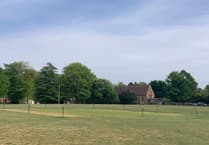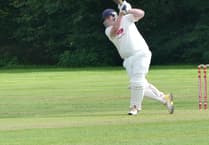He was one of the most distinguished former Farnham cricketers, having played for the town club as a right-arm seam bowler, after learning his craft at nearby Dippenhall.
Vic Cannings was born in the village of Bighton, near Alresford, in April 1919, and like John Arlott, who came from the same neck of the woods, kept his distinctive Hampshire burr all his long life.
He went on to play first-class cricket, first for Warwickshire, and then for his home county throughout the 1950s, sharing the new ball with Hampshire legend Derek Shackleton.
On his retirement, he coached at Eton for many years. One of the many promising young cricketers to pass through his hands was John Barclay, the future captain of Sussex.
In his history of Farnham Cricket Club, published during the club’s bi-centenary year in 1982, Graham Collyer recounts that Cannings was the son of a farm carter who moved from Bighton to Dippenhall, near Crondall, to work for Charles Falkner, brother of the renowned architect Harold Falkner.
He played for the newly formed Dippenhall club as a youngster before being spotted by Farnham.
Those were the great days of club cricket at the Park and Vic, when still only 15, bowled at Jack Hobbs in 1934, the great man’s retirement season.
The next season, he was selected for a district side to play Surrey, again at the Park, and had the formative experience of being hit for five consecutive sixes by the county captain, Errol Holmes.
By 1938, Cannings was serving abroad in the Palestine police and did not play county cricket until after the war.
Hampshire could not afford him initially, so he joined Warwickshire and made his debut in 1947.
In that first season, he took 63 wickets at just under 30 apiece, but thereafter his opportunities were limited, although, in 1948, he had the memorable experience of bowling against Don Bradman.
Hampshire, seeking a partner for Shackleton, approached Cannings and he returned south in 1950, just after his 31st birthday, and took 83 wickets at under 25 each in that first season.
He and Shackleton bowled together for the first time at Lord’s, dismissing Middlesex for 103. One of Vic’s victims was Denis Compton, the first of several times that he dismissed the charismatic England batsman.
In 1952, the pair bowled unchanged in both innings in a victory over Kent at Southampton. In the first innings, Cannings also held three gully catches as Kent were dismissed for 32.
In 1953, he was the only bowler to dismiss the Australians’ Bill Johnson, ending an amazing sequence of 16 not outs in 17 innings.
Shackleton and Cannings helped Hampshire finish third in 1955 and a best-ever second in 1958.
Vic took 100 wickets in four consecutive seasons, 1951-1954, and his 94 wickets in the wonderful 1955 season cost just 17.64 each and an economy rate barely above two runs per over.
Medium-pacer Cannings and the quicker Shackleton were famous for their mastery of line and length and ability to get the best out of a helpful wicket. A batsman waiting for the bad ball to come along usually had to wait an awful long time.
Vic’s batting was less remarkable, with a career average of around 10 and one half-century (for Warwickshire), but in 1950 he and Charlie Knott steered Hampshire from 131-9 to 152 all out and a tie with Kent.
Remarkably, in 1955 at Eastbourne, Cannings and Peter Sainsbury came together at 84-8, with Hampshire chasing 140 for victory. The ninth-wicket pair brought the scores level, at which point Sussex took two wickets without addition and Hampshire recorded the third of four ties in their history, with Vic’s dismissal twice enabling that result.
Cannings specialised in last-minute thrills. In 1955, he had Kent’s Doug Wright lbw with the last ball to win the match, and against Oxford University one year later, Hampshire won by one run when Vic took two wickets with the last two balls of the match.
Vic Cannings was capped early in his careers for both Warwickshire and Hampshire and he added a third later with Buckinghamshire in Minor Counties cricket. He might well have set a record for the shortest time in which a player has won two county caps – after nine weeks at Warwickshire and after five weeks at Hampshire.
“Derek and I were a great partnership in all sorts of ways,” Vic told Graham Collyer. “We got on so well together.”
Shackleton was belatedly recalled by England to play against the West Indies in 1963, but Cannings never got the call from country. “It might have surprised my mother that I was never picked for England, but not me,” he said. “I wasn’t quick enough. There were too many other good bowlers like me around.”
In all, he took 834 first-class wickets for Hampshire in ten seasons at an average of 21.68 – all after his 30th birthday. He had previously claimed 88 wickets for Warwickshire.
He took his benefit in 1959 (£3,787) and was then appointed cricket coach at Eton, where he also ran the school sports shop. He played three seasons for Buckinghamshire and, like many cricketers before him, became a keen golfer, playing at the Army club at Aldershot.




.jpeg?width=209&height=140&crop=209:145,smart&quality=75)
Comments
This article has no comments yet. Be the first to leave a comment.